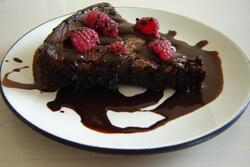My Charoset Bowl: From Female Ancestors, to My Mom, to Me
Pesach is one of my favorite Jewish holidays. Every year, I’m filled with joy as that sense of the approaching spring underlies the smells of cooking brisket and matzoh ball soup. As I rid my house of all the chametz that has accumulated over the past year, I always think about the family and friends who I’ll see in just a few short days. In previous years, during the first two nights of Passover, my house in New Jersey would be packed with relatives coming from all over the country. These days, though, my family and I pack up and head down to our cousins’ home in Maryland. Although our exact annual plans for Pesach seders are ever-changing, especially amidst the pandemic, one constant (besides all the matzoh, of course) has been my wooden bowl. This bowl, though unassuming in its looks, holds an incredible amount of family history. I’m not entirely sure who started the tradition, but I know that at least beginning with my great-grandma, each woman in my family line has passed down the bowl from mother to daughter until, finally, the bowl reached me. This special bowl has one use and one use only: to make charoset.
Every year on Erev Pesach I gather my wine, red apples, walnuts, cinnamon, bench scraper, and bowl, and then I promptly get to work. The art of making the perfect charoset is a fine one, which sometimes includes a bit of hard labor, and always includes—and requires—deep emotions and love. There are no exact written measurements for the ingredients; rather, I place trust in my instincts. Making charoset in my foremothers’ wooden bowl is a critical ritual for me, without which the holiday can’t truly begin. This charoset preparation links me to the women who came before me, and also helps me connect with my family traditions more broadly.
I’ve never actually met any of the previous owners of my bowl aside from my own mom. I’ve heard stories and seen pictures of the various other owners, but I was never able to have conversations with them or discover who they were as people. Through this bowl, though, it’s almost as if I can catch glimpses into their lives, even if they’re just my own interpretations. When I use the wooden bowl, I know that generations of women before me used this bowl for the exact same purpose and even around the same time of year as I do now. In a religion that’s unfortunately rooted in so many patriarchal traditions, it’s so important for me to hold on to a ritual and an object that undeniably connects me to the women who came before me. This tradition allows me to maintain my own space and my own practice that neither my brother nor my dad can touch. It allows me to connect with the women in my family as well as every Jewish woman from the past. Carving out my own space to create my own rituals gives them, and me, a voice where we traditionally have not had one.
While this bowl ties me to many different female ancestors, the most valuable connection it reminds me of is the one I’ve had with my mom. Pesach was probably the most important holiday for her. Weeks in advance, she’d begin buying supplies and scrubbing the house in preparation for all the Passover cooking. And during that eventual cooking process, she’d go all out. She made elaborate meals of brisket, mashed potatoes, matzoh ball soup, and gefilte fish, as well as dessert dishes, for our company of over 20 people two nights in a row. She did all of this while organizing the seder table, decorating it with fun toys like masks and finger puppets. One year, she even made her own Haggadah. Every year, though, in addition to taking on all of these tasks, she always found the time to make charoset with me.
When I was ten, my mom was diagnosed with triple negative stage four breast cancer. Soon after, the hustle and bustle that once filled the house before Pesach disappeared; instead, we started to quietly cook and pack in order to visit our cousins. We no longer host big seders at our house with over 20 people. Still, though, I make charoset in the wooden bowl. I continue to find the time to make it, because when my mom was able, she would always find the time to make it with me.
The act of making charoset in this bowl enables me to go back in time, and relive a bit the feeling of preparing the charoset with my mom back when I was little. Although she’s not here anymore, I’m still able to keep her close and preserve her passion for the holiday; when I make charoset, it makes me feel as if she’s still with me. Through this charoset bowl, I hold onto the opportunity to connect with my mom, as well as my grandma and my great-grandma and who knows how many other female ancestors. The bowl also enables me to create my own Jewish ritual and honor the holiday that my mom and I both love most. Hopefully, in the future, I’ll be able to pass down this precious bowl to my own daughter, and give her the chance to both connect with our family and form her own traditions too.
This piece was written as part of JWA’s Rising Voices Fellowship.







Lovely and meaningful post. Thanks for sharing.